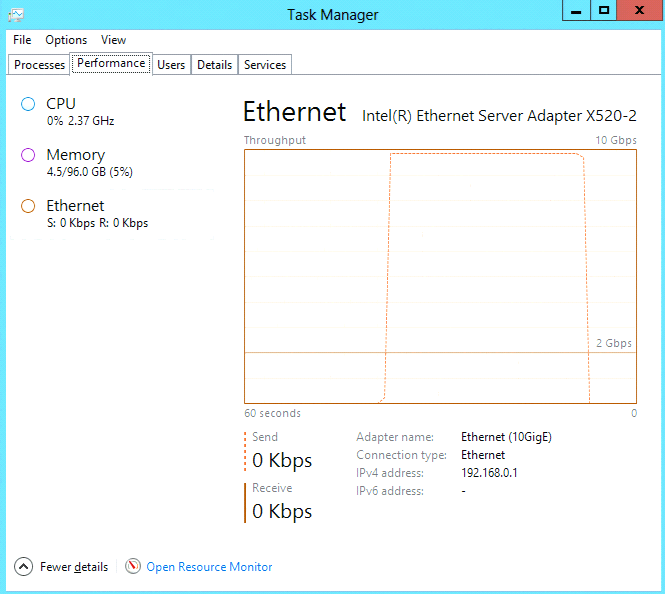NTttcp Version 5.28 Now Available
Leveraged extensively by both external customers and Microsoft Product Groups alike to profile and measure Windows networking performance, updated versions of NTttcp (a Winsock-based port of BSD’s TTCP tool) have remained 'internal-only' for the past five years (the last public version, v3.0, was released in 2008). That is, of course, until now!
Download: NTttcp v5.28
I’m excited to announce that the latest version of NTttcp is now also publicly available, posted on TechNet Gallery bundled with an updated EULA. This latest version (v5.28) brings forth both performance improvements and feature enhancements including:
- Optimizations added for 10GigE interfaces
- Increased platform support: x86, x64 and ARM
- Simplified usage (e.g. sender and receiver functionality determined with a simple parameter switch)
- Dynamic allocation of threads across all system cores (using ‘*’ for the processor ID mapping value)
- Startup order dependency removed (i.e. server/receiver will wait for the other rather than time out)
- Custom warm-up and cool down options available
- Results can be outputted to XML
- Ability to bind sender traffic to a specific IP address
- Synchronization of data ports, useful when running multiple instances
- An option to set the WAIT_ALL flag when using recv or WSARecv functions
Overall, the basic program workflow follows the previously released public version (v3.0), with the most notable exception related to the setup of the sender and receiver. Rather than needing to rename the program based on function, parameters enable the selected functionality: '-s' for the sender and '-r' for the receiver.
For example, to measure the network performance between two multi-core serves running Windows Server 2012, NODE1 (192.168.0.1) and NODE2 (192.168.0.2), connected via a 10GigE connection, on NODE1 (the sender), run:
ntttcp.exe -s -m 8,*,192.168.0.2 -l 128k -a 2 -t 15
(Translation: Run ntttcp.exe as a sender, with eight threads dynamically allocated across all cores targeting 192.168.0.2, allocating a 128K buffer length and operating in asynchronous mode with 2 posted send overlapped buffers per thread for 15 seconds.)
And on NODE2 (the receiver), run:
ntttcp.exe -r -m 8,*,192.168.0.2 -rb 2M -a 16 -t 15
(Translation: Run ntttcp.exe as a receiver, with eight threads dynamically allocated across all cores listening on 192.168.0.2, allocating 64KB buffers [since -l is not specified], a 2MB SO_RCVBUF Winsock buffer and operating in asynchronous mode with 16 posted receive overlapped buffers per thread for 15 seconds.)
Using the above parameters, the program returns results on both the sender and receiver nodes, correlating network communication to CPU utilization. Example sender-side output from a given run (which showcases a fully saturated 10GigE connection at 1131.4 MB/s):
D:\>NTttcp.exe -s -m 8,*,192.168.0.2 -l 128k -a 2 -t 15
Copyright Version 5.28
Network activity progressing...
Thread Time(s) Throughput(KB/s) Avg B / Compl
====== ======= ================ =============
0 30.016 77074.627 131072.000
1 30.016 231692.964 131072.000
2 30.016 115782.516 131072.000
3 30.016 231496.802 131072.000
4 30.016 116072.495 131072.000
5 30.016 77155.650 131072.000
6 30.016 231611.940 131072.000
7 30.016 77633.262 131072.000
##### Totals: #####
Bytes(MEG) realtime(s) Avg Frame Size Throughput(MB/s)
================ =========== ============== ================
33959.125000 30.016 1456.355 1131.367
Throughput(Buffers/s) Cycles/Byte Buffers
===================== =========== =============
9050.939 2.453 271673.000
DPCs(count/s) Pkts(num/DPC) Intr(count/s) Pkts(num/intr)
============= ============= =============== ==============
40284.215 1.228 51434.235 0.962
Packets Sent Packets Received Retransmits Errors Avg. CPU %
============ ================ =========== ====== ==========
24450576 1485400 0 0 4.559
And here is a Task Manager screenshot profiling the run:
Note that in keeping to the theme of making this latest version’s operation more robust, dynamic and streamlined, the following options are no longer available and/or replaced with new functionality:
-x [PacketArray size]
-i Infinite Loop
-f <File Name>
-fr Full buffers posted on reads
-mb Multiple buffer post mode
For more information about specific parameters and options, please reference the documentation included with the previous version and/or run the tool without arguments to display all supported options. And stay tuned for future blog posts detailing the expanded functionality and additional use cases available with this latest version.
Download NTttcp v5.28 today!
Josh Adams
Senior Program Manager
Windows Server & System Center
